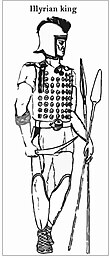Battle of Stratos
| date | 429 BC Chr. |
|---|---|
| place | Stratos in Acarnania |
| output | Defense against the barbarians and Peloponnesians |
| Parties to the conflict | |
|---|---|
|
Sparta , Ambrakia , Leukas , Anaktorion , Chaonians , Illyrians |
|
| Commander | |
|
Knemos , Photys, Nikanor, Sabylinthos, Oroidos |
|
| Troop strength | |
| over 10,000 warriors (1,000 Peloponnesian hoplites , 1,000 Chaonians, 1,000 Orestes and many more) |
significantly less, many slingshots |
Sybota - Potidaia - Spartolus - Stratos - Naupactus - Plataea - Olpai - Tanagra - Pylos - Sphacteria - Corinth - Megara - Delion - Amphipolis - Mantinea - Melos - Syracuse - Miletus - Syme - Eretria - Kynossema - Abydos - Kyzikos - Ephesus - Chalcedon - Byzantium - Andros - Notion - Mytilene - Arginus - Aigospotamoi
The Battle of Stratos was a battle in the Peloponnesian War that began in the summer of 429 BC. Chr. In Akarnanien an invasion by a united army of Peloponnesians , Ambrakiern and Illyrian barbarians was blocked.
The barbarian invasion
In the summer of 429 BC The conflict broke out between the Akarnans, allied with Athens , and their northern neighbors in Ambrakia , when the Ambrakians and the Chaonians allied with them made an attempt to conquer all of Akarnania in order to steal it from Athens. To do this, they called the Spartan sea lord Knemos to help, who immediately translated with 1,000 hoplites from the Peloponnese without the Athenian guard in Naupaktos noticing. Since the Ambrakians had already gathered a strong army, they immediately began the campaign.
The 1,000 Peloponnesians, further contingents of heavily armed men from Ambrakia, Leukas and Anaktorion as well as a large number of Illyrian barbarians were involved : 1,000 Chaonians among their annual chief officials Photys and Nikanor, with whom a group of Thesprots marched, a contingent of Molossians and Atintans under Sabylinthos Guardian of their king, as well as a contingent of Paranaians under their king Oroidos, with whom 1,000 Orestes marched . Assuming that each band comprised at least 500 warriors and the more important ones, like those from Ambrakia, also significantly more than 1,000, an army of more than 10,000 armed men should have come together.
The march
After devastating the area around Argos Amphilochikon and the hamlet of Limnaia, they moved towards Stratos , the largest city in Akarnania, believing that the rest of the country would surrender easily after the fall of its capital. The Akarnans had not united to defend themselves, but each city sought to protect itself. A request for help to the Athenian general Phormion in Naupaktos was also in vain , as he was unable to comply with the threat from a Corinthian fleet at the moment.
On their way south, the invaders marched on three different paths, corresponding to the terrain, which was criss-crossed by two mountain ranges running in a north-south direction. The Leucadians and Anaktorians advanced on the right wing next to their homeland, the Ambrakians and Peloponnesians under Knemos on the left and the barbarians marched through the valley in the middle. They were so far apart from each other that there was often no visual contact. The Greeks on the western and eastern mountain flanks proceeded in an orderly manner and set up fortified camps after their arrival. The chaons at the head of the barbarians believed they didn't need to, and when the city came into view, they stormed off with wild cries, trying to take the walls alone in the first storm.
The battle

The Stratians, however, had learned of the enemy march and had taken their precautions. So they had ambushed their warriors at suitable places around the city and on the mountain foothills. When the barbarians stormed the city walls, they suddenly broke out on both sides and chased them back. The Chaons lost many men, and by their hasty retreat they also tore the other barbarian tribes into unstoppable flight.
The Greek armies, busy with the construction of the camp, had not noticed anything of the fight and only became aware of the arrival of the refugees. They then pooled their armies and otherwise remained inactive. Without the support of the rest of the Akarnans, the Stratians were still outnumbered and therefore did not dare to engage in close combat. Instead, they hit the intruders down from the hills with their slingshots to such an extent that it was impossible to move without armor.
The withdrawal
Under the impression of defeat and fear of the arrival of the rest of the Akarnans, Knemos withdrew that night. The next day he hid the dead under the cover of a truce, and then went back to his fleet to take part in the second battle of Naupaktos .
The consequences
The Battle of Stratos was a major victory for the Greeks over the Illyrian barbarian tribes in Epirus. Akarnania remained a loyal ally of Athens, who three years later sent its general Demosthenes to defend Argos Amphilochicon and to give the Ambraki an even bloodier lesson at the Battle of Olpai .
Individual evidence
- ↑ Thucydides , II 80.
- ^ Thucydides, II 81.
- ^ Thucydides, II 81.
- ↑ Thucydides, II 82 and 85f.
